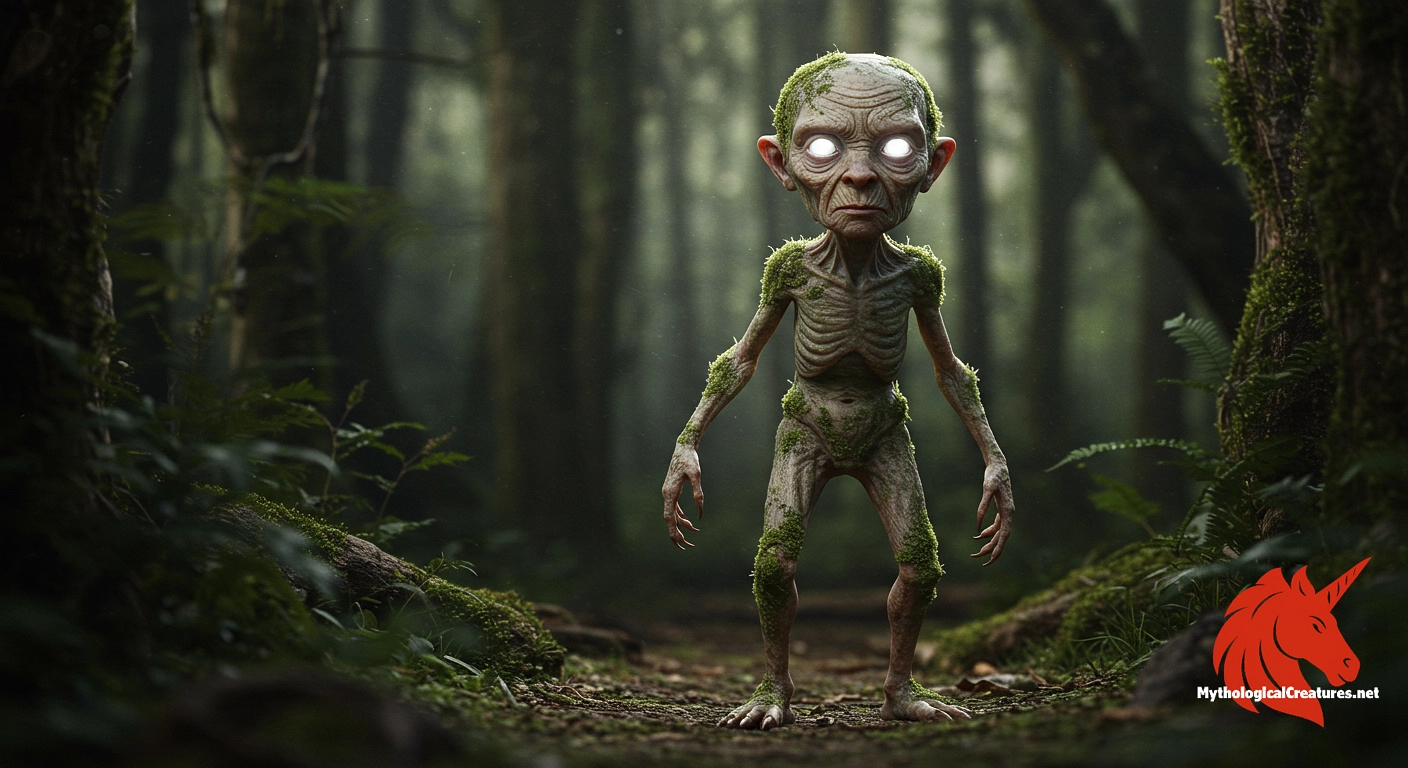Chaneque: Chaneques are small, sprite-like beings in Mexican folklore that serve as both guardians of nature and mischievous tricksters.

Chaneque
Chaneque - Embodies the blending of indigenous beliefs with colonial narratives, representing both protective and harmful supernatural aspects in Mexican cultural heritage
Origins & First Encounters
In the rich tapestry of Mexican mythology, the Chaneque emerges as a mysterious embodiment of both nature’s guardianship and a playful yet enigmatic trickster spirit. Believed to be ancient and deeply intertwined with the natural world, this creature derives its name from a Nahuatl expression that hints at inhabiting dangerous or sacred places. Early records by pre-Columbian societies attest to its dual nature, where it is revered as a protector of homes and wild spaces while also being capable of causing unexpected mischief. The Chaneque represents the delicate balance between reverence for nature and caution in the face of the unknown, reflecting an indigenous worldview that sees the natural landscape as alive and imbued with spiritual forces. Its presence within myth and legend underscores the intimate connection between the land and its inhabitants, serving as a living reminder of the mystery that surrounds the natural environment. The Aztecs and other Mesoamerican cultures incorporated these beings into their religious and daily life, often as a way to rationalise the unexplained phenomena of the wilderness.
Stories passed down through generations have further enriched its character, blending elements of folklore with personal experience and communal memory. Cultural narratives continue to portray the Chaneque as both a guardian and a trickster, a being that challenges the boundaries between security and peril. Over time, these legends evolved, absorbing influences from colonial interpretations and modern reinterpretations without losing their ancient core. Thus, the Chaneque remains a compelling figure in the evolving cultural and mythological heritage of Mexico.
Source Texts & Tale Variants
Ancient documents and oral traditions have played a crucial role in preserving the lore of the Chaneque. Colonial manuscripts and early ethnographic accounts occasionally mention these elusive beings, blending indigenous myth with newly imposed cultural frameworks. Early Aztec codices and notes from Spanish chroniclers provide fragmented glimpses of their existence, often aligning them with elemental forces and the mysterious spirit of the wilderness. Some records portray the Chaneque as benign protectors of households and natural sites, while others cast them in a more ominous light. This variability in depiction has helped shape a multifaceted myth that adapts to the changing contexts of its tellers.
Beyond the pages of historical texts, oral traditions have kept the legend alive among local communities. Diverse story variants recount instances where the Chaneque lures travellers astray or causes inexplicable memory lapses, suggesting a role in the transition between the natural and supernatural. Many versions of the tale emphasise a ritualistic dimension—be it the use of dried trees as portals or specific rites to restore a lost soul—thereby intertwining everyday life with the mysterious Otherworld. The evolution of these narratives reflects a dynamic interplay between indigenous spirituality and later cultural influences, ensuring that the myth of the Chaneque remains as vibrant as ever. Each retelling adds yet another layer to an already complex mosaic of belief.
Form & Powers
Descriptions of the Chaneque vary widely, presenting a creature that is as elusive in form as it is in spirit. Often depicted as diminutive and agile, it carries an uncanny blend of youthful features fused with hints of age and wisdom. Some traditions recount the appearance of a small child bearing the subtle, weathered countenance of an elderly person, an attribute that adds to its mysterious duality. These beings are typically attributed a slight build, suggesting an ability to dart silently through dense vegetation or shadowed corners of ancient dwellings. Their physical presence is often shrouded in an aura of natural mystique, reflecting the interplay of light and shadow in secluded forest clearings.
Intricate details in various accounts reveal the possibility of luminous eyes that seem to capture the flicker of an inner fire, along with simple attire fashioned from natural fibres and earthen hues that help them blend with their surroundings. Descriptions sometimes highlight dishevelled or wild hair, evoking the untamed spirit of the nature they inhabit. Although consistently noted as small in stature, the impact of their presence in local narratives is disproportionately large, leaving a vivid imprint on the collective imagination. While there is some divergence in the specifics across different regions, the general consensus paints the Chaneque as a mystical denizen whose very form is both beguiling and otherworldly. These detailed portrayals serve to enhance the creature’s role as a bridge between the tangible world and the realm of the supernatural.
Regional Faces
Regional interpretations of the Chaneque reveal a fascinating interplay between local geography and distinct cultural beliefs. In central and southern Mexico, particularly in areas defined by rugged terrain and dense forests, these creatures are seen as capricious guardians who both protect and challenge the human presence in nature. Diverse communities view the Chaneque through lenses coloured by their environmental realities, with some local narratives describing them as dwelling in hidden groves or beneath the boughs of ancient trees. The story is often interwoven with the surrounding landscape, where the creature comes to symbolise the inherent power and mystery of the wild. Elements of local tradition provide the Chaneque with roles that blend protective charm with cautionary warnings about disturbing sacred natural places.
In the Yucatán Peninsula, analogous beings known as aluxob hold a similar place in local myth, yet they are presented with nuances that resonate strongly with Mayan cosmology. These regional variations highlight a spectrum of interpretations, where the creature might be revered as a beneficent spirit or in more mischievous terms as an instigator of small misfortunes. In mountainous or rural areas, the presence of such entities serves as a cultural touchstone, inspiring both respect and apprehension. This diversity in practice and belief underscores the adaptability of the Chaneque myth, allowing each community to imbue it with its own environmental and spiritual significance. Ultimately, regional adaptations enrich the overall tapestry of the myth, demonstrating how one legend can embody multifarious cultural identities.
Cultural Parallels
Across various global mythologies, the Chaneque finds intriguing parallels with other diminutive nature spirits and elusive fae. Similar to the duende in Spanish tradition and the pixies of European folklore, these beings act as both guardians of hidden spaces and playful disruptors of human order. The thematic resonance between the Chaneque and creatures like Ireland’s leprechauns underscores a universal appeal for beings that dwell on the fringes of the known world. Such parallels highlight common human attempts to personify the mysteries of nature, transforming unexplained natural phenomena into accessible, if capricious, entities. This cross-cultural mirroring reveals shared archetypes in myth-making that span continents, suggesting that the lure of the mystical and the mischievous transcends specific cultural boundaries.
Other Latin American traditions contribute to this intertextual dialogue through creatures that call themselves duende or Agua Viva, each bearing similarities to the Chaneque. Comparative folklore studies often note behavioural overlaps, such as the propensity to lead travellers astray or the dual nature of bestowing both fortune and misfortune. These cross-cultural comparisons allow for a richer understanding of the Chaneque by situating it within a broader narrative of nature spirits. The symbolic traits—whether it’s the blend of protection and mischief or the association with the elemental forces—demonstrate common motifs in mythologies worldwide. This comparative analysis not only deepens our appreciation of the Chaneque but also emphasises the shared human fascination with the unseen guardians of the natural realm.
Legacy & Modern Evolution
Over the centuries, the portrayal of the Chaneque has undergone a remarkable evolution that mirrors shifting cultural and societal landscapes. Early indigenous narratives portrayed the creature as a subtle guardian of nature whose mischief was tempered by a protective instinct. During the colonial period, however, interpretations shifted dramatically as these beings were frequently cast in a more malevolent role, with some accounts associating them with demonic forces. This transformation reflected broader societal attempts to reframe indigenous legends within a framework that was more acceptable to European sensibilities. Despite these reconfigurations, the core duality of the Chaneque—its capacity for both benevolence and mischief—remained a constant thread in folklore.
In contemporary culture, modern writers, filmmakers, and artists have rekindled interest in this ancient myth, reinterpreting the Chaneque as a symbol of environmental stewardship and the enduring mystery of the natural world. Today's portrayals often balance the creature's trickster tendencies with a renewed appreciation for its role as a protector of nature. Its presence in literature and media invites a re-examination of our relationship with the environment, highlighting themes of respect, caution, and coexistence. As modern society grapples with issues of environmental degradation and cultural loss, the Chaneque has emerged as an icon of traditional wisdom and the resilience of indigenous narratives. This ongoing legacy cements its place as a bridge between the ancient and the contemporary, speaking to the timeless appeal of myth and the human need to understand the forces that shape our world.
Interesting Fact
An intriguing aspect of chaneque lore is their association with dried kapok trees, which are believed to serve as portals to the Underworld in some traditions.
Quick Creature Info
Origin:
Features:
Associations:
Our Mythic Legendary Rating:

Also Sometimes Known As:
Habitat:
Supernatural Powers:
Physical Attributes:
Abilities:
Behavior:
Weaknesses:
Lore:
Related Creatures, Tales or Lore
- DDuende
- AAluxob
References
Discover Another Mythical Legend You May Not Have Heard Of?
Uncover the mysteries of ancient folklore and expand your knowledge of legendary beings from cultures around the world.
Dare to Meet the Hundun....
Mythical Disclaimer: The images and data on this site are derived from various historical and literary sources, but we have found that many myths often have multiple versions and interpretations across references, sometimes contradictory. As a result, these creature depictions are artistic interpretations—imaginative blends of folklore, legend, and a dash of AI guesswork. Because creature descriptions vary widely, our illustrations and accompanying information represent our best effort to honor mythology while bridging creative gaps. Enjoy these interpretations—just remember, we've done our best to respect the stories and validate available data, but in the realm of mythology, details often shift, imagination leads the way, and nothing is ever set in stone!
Curated by the Mythological Creatures Team (rev. May 2025)
